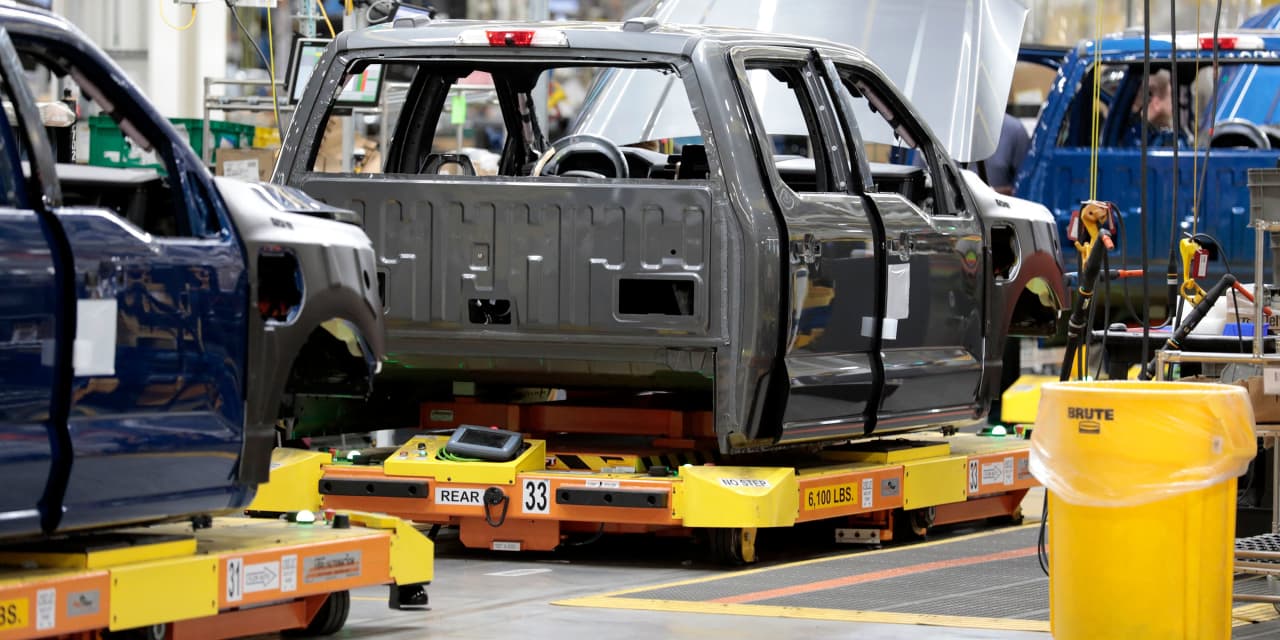A slowdown in F-150 Lightning production will have Ford investors asking what’s going on. The truck is built at the Rouge plant in Dearborn, Mich.
Jeff Kowalsky/AFP via Getty Images
Figuring out what’s going on at
Ford Motor
or the other Detroit-Three auto makers isn’t easy. Everything needs to be filtered through labor negotiations, a slowing economy, supply-chain issues, and the electric vehicle transition.
Take Ford’s decision to slow production of its all-electric F-150 Lightning pickup trucks. The Wall Street Journal reported Saturday that Ford (ticker: F) was canceling a shift at its Rouge assembly complex in Dearborn, Mich., citing a memo from the United Auto Workers.
UAW officials blamed falling sales. The Union didn’t respond to a request for comment about the memo.
Canceling an entire shift due to weak demand might be an overstatement. “We are adjusting the schedule at the Rouge Electric Vehicle Center because of multiple constraints, including the supply chain and working through processing and delivering vehicles held for quality checks after restarting production in August,” Ford said in an emailed statement.
Ford paused production of the Lightning in February due to battery issues. Production resumed in August. The pause hit sales. Ford delivered about 8,700 Lightning trucks in the U.S. between March and September. That’s down from about 8,900 delivered over the same span of 2022.
Without any supply chain constraints or battery problems, the 2023 number might have been north of 20,000 units delivered between March and September.
The strike shouldn’t be impacting the Lighting. About 16,600 Ford workers represented by the United Auto Workers are on strike. The strike began on Sept. 15. It has been expanded a few times, including on Wednesday at Ford’s Kentucky Truck Plant, which builds Ford super-duty trucks. Other affected products are Broncos and Explorers.
About 2,500 additional UAW workers have been laid off because of disruptions to the production system caused by the strike.
A slowing economy might deserve some of the blame. A lot of trucks are purchased by businesses, and the U.S. manufacturing economy has been shrinking for 11 consecutive months. What’s more the average interest rate for financing new vehicle purchases is up about 3 percentage points over the past 18 months, making it more expensive to buy.
The 2023 Lightning sales number is a disappointment, but it’s going to take investors a few months longer to decide how to allocate blame for flat F-150 sales.
Investors have been very focused on the UAW strike lately. It’s weighing on shares of Ford and
General Motors
(
GM
). Through Friday trading, Ford and GM stocks were down about 21% and 27%, respectively, over the past three months, while the
S&P 500
was down about 4%.
Stellantis
(STLA) shares are up about 4%, but the auto maker is a more global company and its shares are cheaper than the other two stocks.
Stellantis
stock trades for less than four times estimated 2024 earnings. Ford and GM shares trade for less than seven and five times, respectively.
Write to Al Root at [email protected]
Read the full article here










